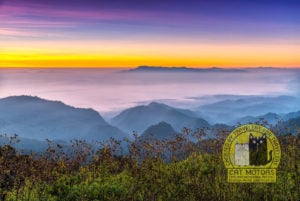Bua Tong Sticky Waterfall In Chiang Mai: A 328 Feet Long Water Wonder
Have you heard about Sticky Waterfall in Chiang Mai? If you enjoy nature and are for an inexpensive day trip in northern Thailand, it’s definitely an attraction to visit. This fascinating water feature, also called Bua Tong (or Bua Thong) Waterfall, not only looks unlike any other waterfall you’ve seen, but you can climb it, too!
The Sticky Waterfall is about ninety minutes from the city. We prepare scooter rental in Chiang Mai with helmets and insurance for this route. Riders can choose 125–160 cc for standard travel or 300–350 cc for stronger uphill performance.
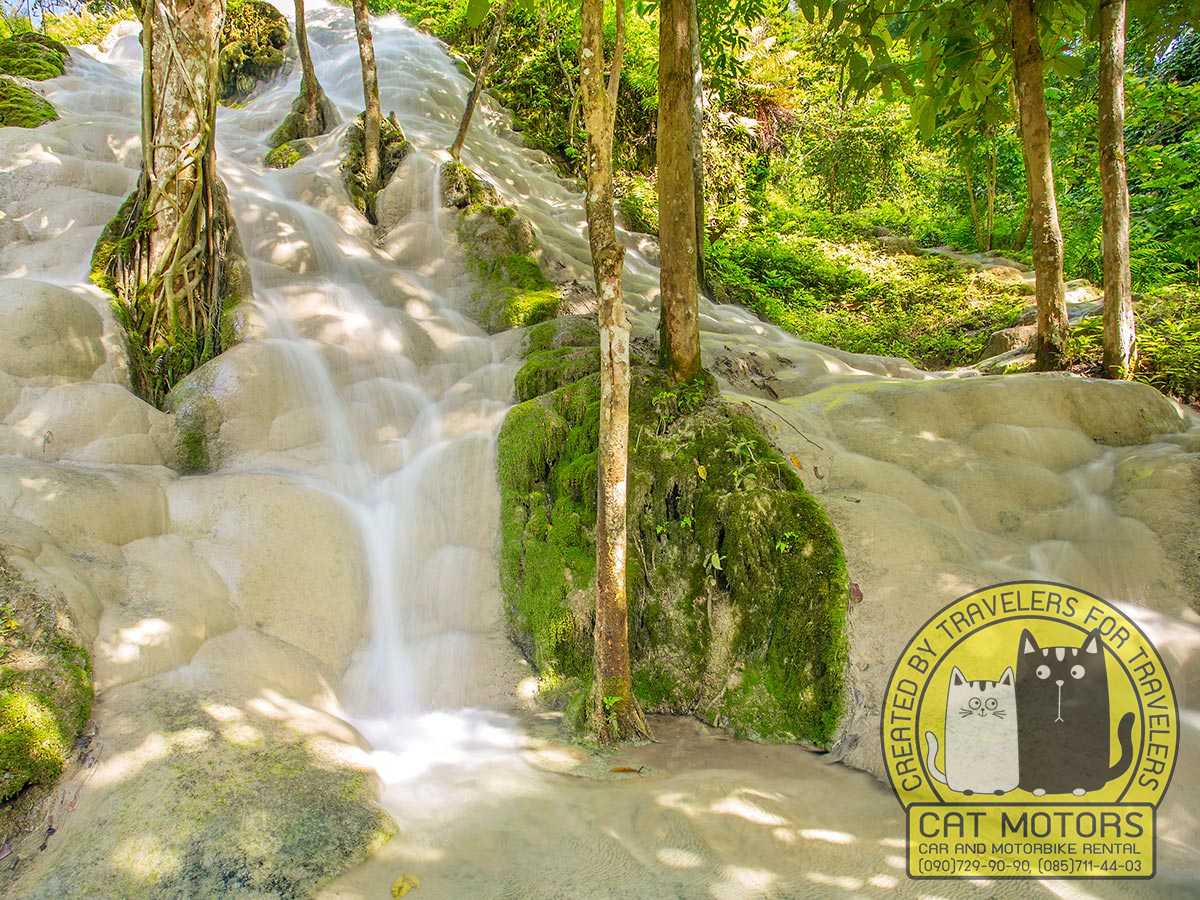
It’s not that the water is sticky. Quite the opposite: it’s crystal clear. However, the minerals in the water coat the rocks beneath to create what looks like giant, squishy marshmallows. Looks can be deceiving, though, as the bulbous rocks are firm and grippy, allowing you to ascend or descend them with relative ease.
Read on to learn about this gem in the Sri Lanna National Park Forest, how to get there, and how to best enjoy it.
The Waterfall’s Origin
According to legend, the story behind the origin of the sticky falls in Chiang Mai is as follows:
Many centuries ago, two Lanna Kingdom princesses, Bua Tong and Bua Kaew, escaped to the area after invaders murdered their parents. A loyal soldier who wished to protect the two princesses took them to a cave to hide there. As time went on, more refugees escaped to the shelter. However, there was no water to drink.
The princesses prayed for water, so God ordered Mae Thorani – the goddess of water – to create underground rivers. The underground water started flowing from a mineral geyser called Nam Phu Chet Si, which means “Seven Colors.” As a result, the enthralling waterfall was named after Princess Bua Tong, and the spring is considered a holy site.
Natural Wonder Of Sticky Waterfall In Chiang Mai
You might be pondering the science behind what makes Sticky Waterfall so “sticky.” This attraction got its name because it is not slippery like most other falls in Thailand. Perhaps a better term is “grippy,” as neither the rocks nor water stick to you. Instead, the rocks are covered in a mineral deposit that feels like a hardened sponge or pumice stone, allowing bare feet to get traction like Velcro.
The cause for this phenomenon is the magnesium- and calcium-rich water that flows from the limestone-rich karst spring that feeds the waterfall. Given the ambient temperature, tufa builds up on the rounded rocks as the water cascades down the waterfall. The presence of tufa hinders algae growth, which is slippery.
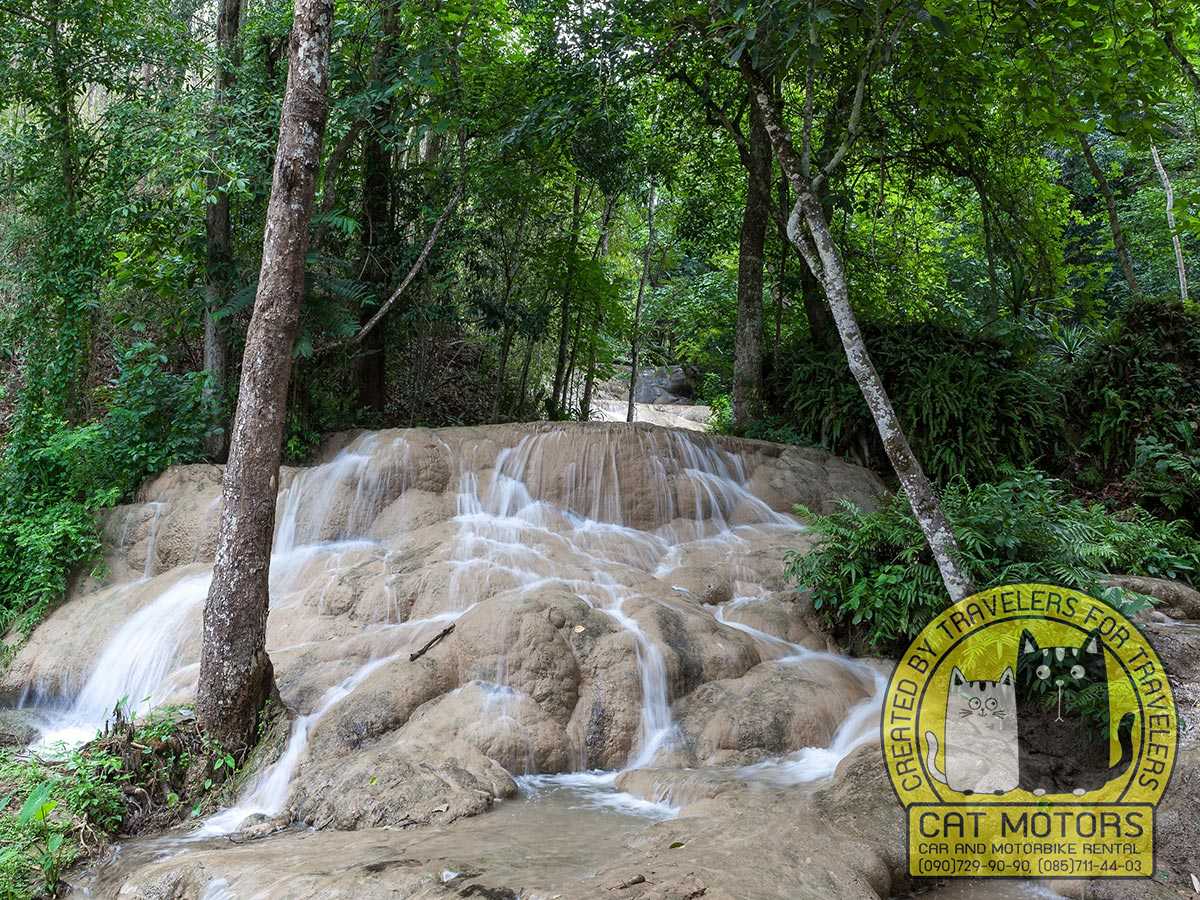
Having explored the unique wonders of Bua Tong Sticky Waterfall in Chiang Mai, you might be intrigued to discover more of the region’s natural aquatic marvels. Chiang Mai is home to a plethora of stunning waterfalls, each offering its own unique beauty and adventure. For a deeper dive into these natural treasures, check out our guide on Chiang Mai waterfalls at Mae Sa, featuring the best spots for a refreshing swim and scenic hikes.
The limestone rocks feel slightly prickly to touch but give slightly to pressure. Many who have climbed this waterfall say they felt like they had Spiderman abilities, especially on almost vertical surfaces (80°).
Flora And Fauna In The Vicinity Of Sticky Waterfall
Bua Tong Sticky Waterfall is one of the many Sri Lanna National Park waterfalls. In this vicinity, you will discover a lush forest area with headwater sources and lots of wildlife. The forest types in the park include moist evergreen, mixed deciduous, dipterocarp, and hill evergreen. Some tree species found include the following:
- Cinnamomum iners,
- Dalbergia oliveri,
- Dipterocarpus obtusifolius,
- Dipterocarpus tuberculatus,
- Hopea odorata,
- Irvingia malayana,
- Lagerstroemia calyculata,
- Pterocarpus macrocarpus,
- Shorea obtusa,
- Shorea siamensis
- Tectona grandis,
- Toona ciliata, and
- Xylia xylocarpa
Fauna and birdlife you might be fortunate to see at Bua Thong Waterfall include the following (but watch out for snakes):
- Asian Black Bear,
- Macaque,
- Northern Red Muntjac,
- Sambar Deer,
- Siamese Hare,
- Tiger,
- Wild Boar,
- Barbet,
- Bulbul,
- Coucal,
- Lesser Whistling-Duck, and
- Little Egret
Exploring Bua Tong Sticky Waterfall
Sticky Waterfall is 100m (328 ft) long, consisting of three tiers. The water emanates from the Nam Phu Chet Si spring. You can easily visit the spring via a walkway; however, you may not swim in it as it is a holy site.
Alongside the falling water is a wooden walkway with hand railings, erected in 2019 by the Parks Department. Many prefer to walk to the bottom of the walkway and climb up. However, the path does loop and takes about 45 minutes to walk if you do not play in the waterfall.
You will discover many shaded spots along the path where you can either sit and relax or use them as a base to explore the falls.
Other places to explore around the waterfall are the less-frequented Bua Tong Temple and Cave on the right-hand side of the road. The temple has a pagoda, assembly hall, and other buildings and statues. One of the secondary buildings is a sala which hosts a bamboo-woven image of Buddha.
You must take a blue Naga staircase to get to and from the cave. Inside the cave is a gilded Buddha statue with many smaller statues. The cave has a strong smell of guano, but you don’t regularly see the bats as they are well hidden.
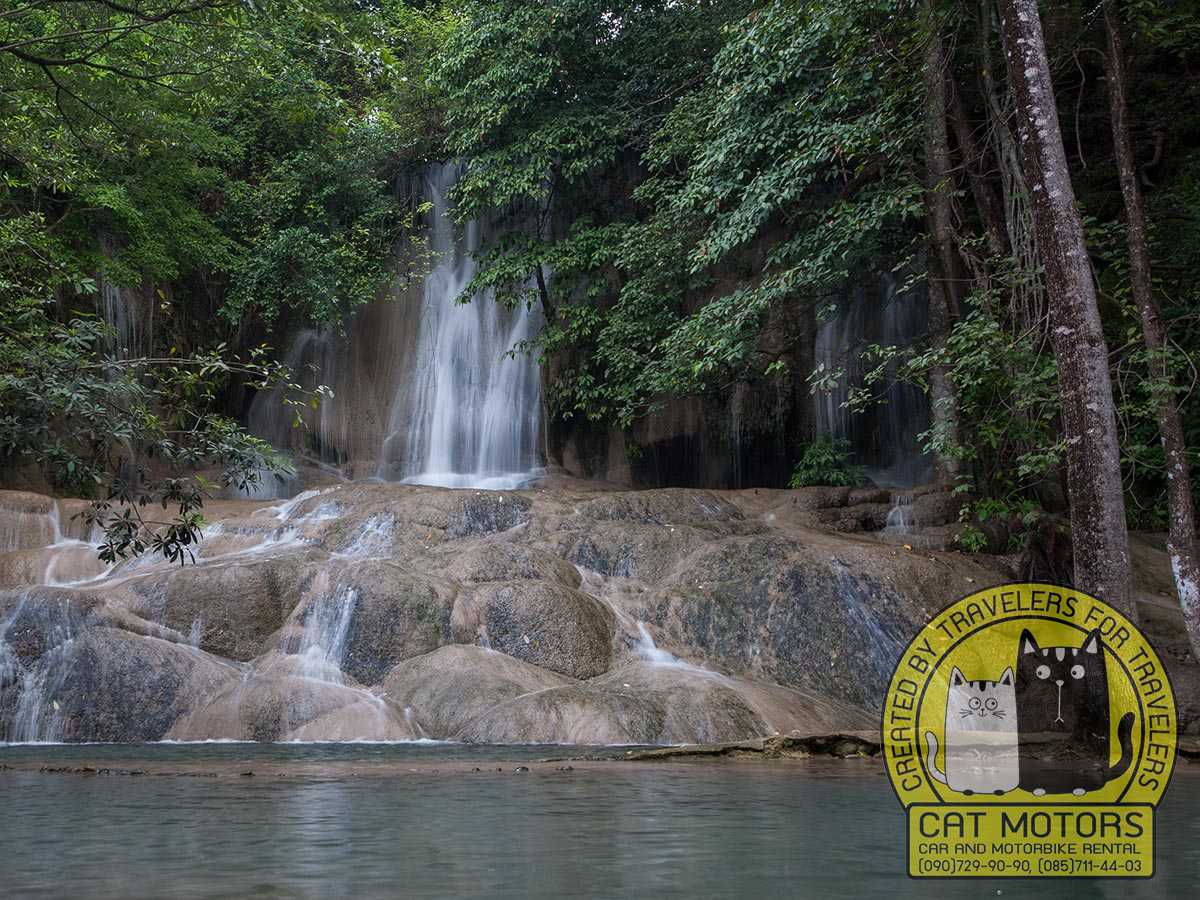
The waterfall and surrounding area are managed by the Parks department. As such, the site is well-kept and clean and has excellent facilities like changerooms with showers and lockers for storing your belongings (about 30 baht).
Fun Activities To Do
Sticky Waterfall offers a few fun activities for visitors, and the best part is that they are free! There is no entrance fee to visit the park, meaning you can stay for as long as you like and explore to your heart’s content.
Here are some activities you can enjoy:
- Climbing up and down the waterfall,
- Swimming at the bottom of the fall,
- Relaxing in a shady spot,
- Feed the fish in the park’s fishpond,
- Have a picnic or barbecue at one of their picnic sites,
- Enjoy Thai food at the open-air market nearby,
- Hiking or trekking around one or more of the park’s nature trails,
- Observe nature, and
- Take lots of photos.
Tips For Visiting
Here are a few helpful tips for when you visit this natural attraction:
Best Time To Visit
The Bua Tong Sticky Waterfall area is open from 8 am to 5 pm daily, so it is best to get there early enough to make the most of it. It’s advisable to go as early as possible in the mornings to avoid the midday heat. The prettiest time to visit is after the rainy season (from November), as the water flows strongly and looks even more spectacular.
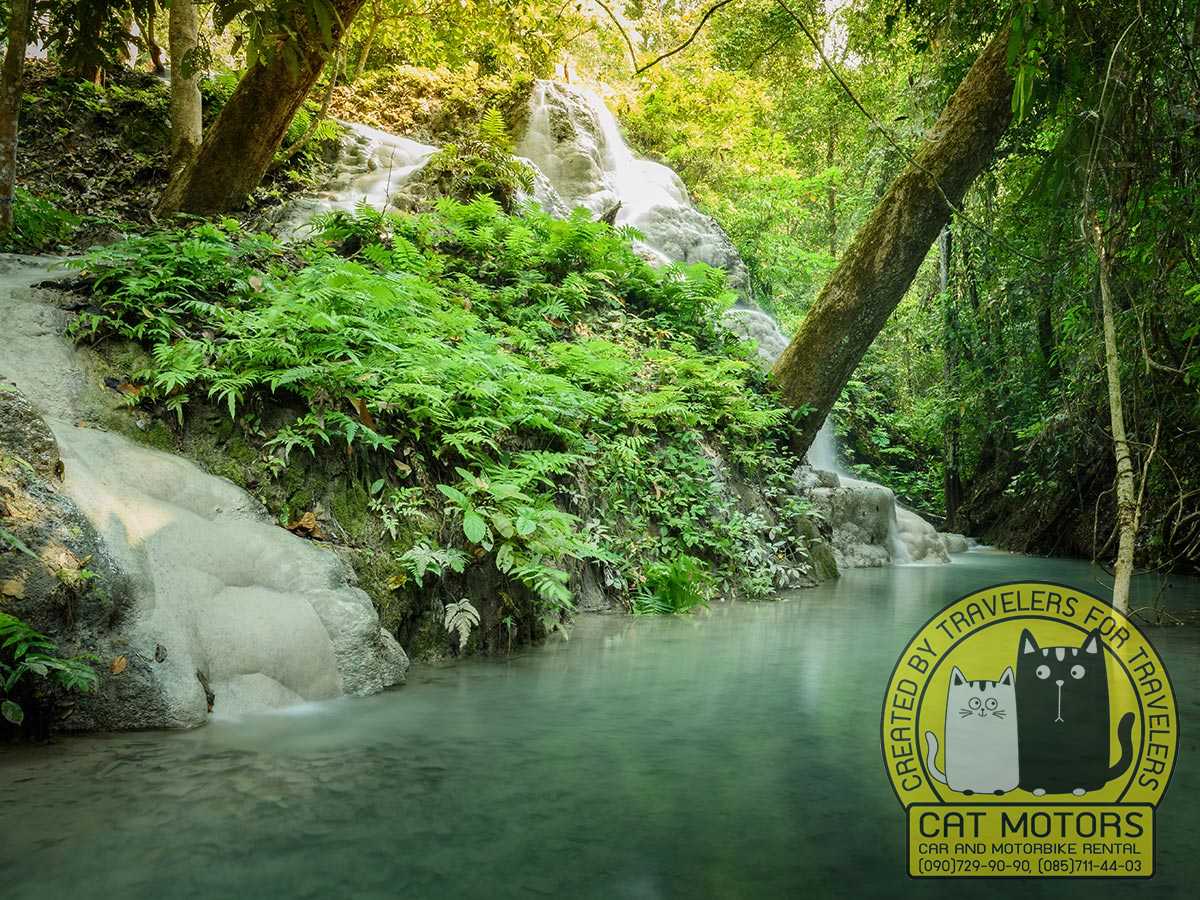
Regarding crowds, it’s is still a relatively quiet place to visit. However, as expected, it can get a little busier over weekends.
What To Wear And Bring
When visiting the waterfall, it is wise to pack the following to make the most of your time there:
- Bathing suit and towel (you can rent a swimsuit onsite if you forgot yours),
- Spare change of clothes,
- Suitable walking shoes,
- Sunscreen and insect repellant,
- Tissues or toilet paper,
- Drinking water,
- Picnic goods if you plan to picnic there,
- A camera and waterproof bag, and
- Some cash in case you want to buy food or drink at the onsite café.
Safety Precautions To Keep In Mind
Below are some safety precautions and considerations when planning your visit to Sticky Waterfall:
- Temperatures are very high (>27°C or 81°F) from March to May, so be wary of becoming dehydrated if visiting during this time.
- Beware of slipping and falling. Some places with algae on the waterfall can be slippery. Additionally, the walkway alongside the fall might be slippery after rain. There are climbing ropes in some areas where it is slippery.
- If you don’t have water shoes, climb the waterfall barefoot to gain more traction.
- Around the park are signs indicating the presence of snakes. While it’s not common to see them, you should still watch your step.
- The park is wheelchair-accessible; however, the waterfall is not.
- Remember to only pay your taxi or Songthaew driver when you return to Chiang Mai. If you pay at the park, they have no reason to wait for you, leaving you with a challenge regarding returning to Chiang Mai.
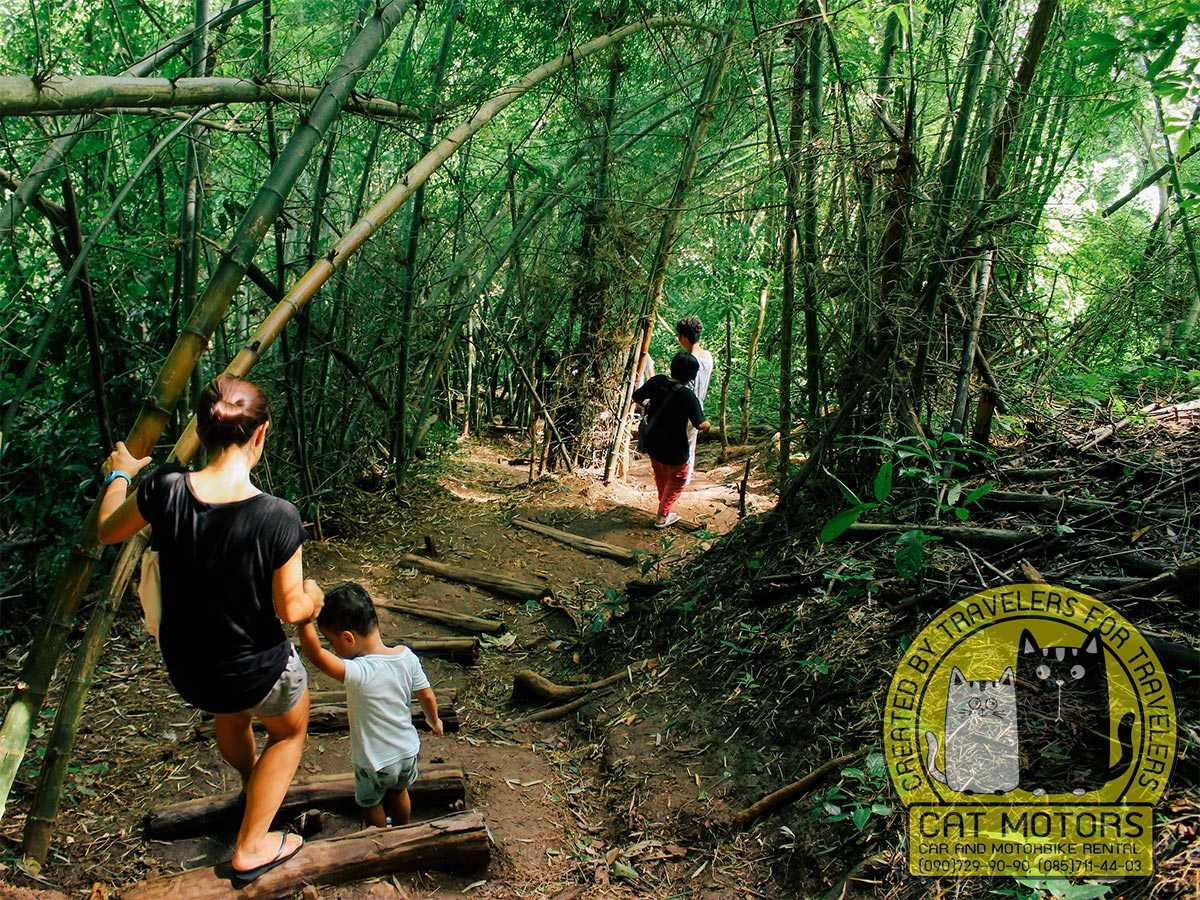
Location And Accessibility
The Sticky Waterfall is situated in Sri Lanna National Park, approximately 60 km (37 mi) north of Chiang Mai City. The exact address is 1009 Mae Ho Phra, Mae Taeng District, Chiang Mai 50150, Thailand.
This is how to get there from Chiang Mai if you’re driving there yourself:
- Leave early in the morning (preferably).
- Head North out of the old town, watching out for the one-way roads around the moat.
- Follow Route 107 North for about 35 km (21.7 mi).
- Turn right onto Route 1414 (near the airplane café landmark).
- At the T-junction (Route 1010), turn left.
- Stay on Route 1010 country road for 22 km (13.7 mi).
- The signage will indicate a right turn to the waterfall.
Depending on the mode of transport you use, it can take a little over an hour to more than two hours to get there. Let’s look at your options to get there:
Hire A Scooter Or Car
Hiring a scooter is the cheapest way to get to Sticky Waterfall, but it will take longer. It’s highly recommended to rent a scooter with a larger engine capacity, as it is a longer ride winding up a mountain, e.g., a Honda Click or 125cc motorbike. It can get a little cool on a scooter, so consider taking a jacket or windbreaker.
Ensure you have a valid international or Thai license endorsed for riding a bike. The police regularly set up roadblocks along this route, and those without a valid permit will be fined between 500-100 baht.
If you hire a car, you can expect to pay about the same as catching a taxi or Songthaew. However, you will have more freedom to explore at your leisure.
Whether you hire a scooter or car, avoid the hectic main road traffic out of Chiang Mai by taking the side road, Route 1001.
Catch A Taxi Or Songthaew
When you catch a taxi or Songthaew to Sticky Waterfalls, your driver will most likely wait for you, ensuring you have transport back to Chiang Mai. Be sure to negotiate a fare (including your driver’s waiting time) before getting in and pay at the end of your excursion.
A decent taxi or Songthaew round trip fare should cost between 1000-1500 baht per vehicle, so the more passengers, the lower the individual rate.
Go With A Tour Guide
It’s not necessary to have a tour guide to enjoy the waterfall. However, it might be a good idea to pick a tour package that takes you on a trip from Chiang Mai to the attractions near Bua Thong Waterfall. These tour packages might include visiting an elephant sanctuary or Doi Suthep temple.
Grab A Grab
Grab is Southeast Asia’s ride-sharing version of Lyft and Uber, and it’s handy for visiting a specific place in Thailand. You must download the app, then enter “Sticky Waterfalls” to get a price estimate. You have the option to pay in cash or by credit card.
Nearby Attractions And Places To Visit
Elephant Nature Park Chiang Mai
Many elephant parks in Thailand make money by offering tourists elephant rides, which is unethical. However, Elephant Nature Park is one of the few ethical elephant reserves in Northern Thailand.
Wat Phra That Doi Suthep
Wat Phra That Doi Suthep is located 11 km (6.8 mi) north of Chiang Mai, en route to Sticky Waterfall. Locals consider this the “most important” temple in Northern Thailand due to the Buddha relics enshrined there. You can also appreciate the seven-headed serpent statues lining the stairs to the temple.
Dantewada Land Of Angels Waterfall Park
Dantewada Land of Angels Waterfall Park is a relatively new tourist attraction about 45 minutes north of Chiang Mai. At this park, you can appreciate artificial waterfalls (feel free to crawl through them!), stunning flower fields, and cute farm animals at the petting zoo.
Wat Si Don Chai Pa Tung Ngam (Hell Temple)
Wat Si Don Chai Pa Tung Ngam is Chiang Mai’s “Hell Temple” that serves as a reminder of what would happen to you if you neglect to follow Buddha’s teachings and live in sin. The temple, also north of Chiang Mai City, has many unsettling graphic statues and imagery of death and despair.
Quick Facts
Name: The Bua Tong Sticky Waterfall, also known as Nam Phu Chet Si, holds a poetic name when translated to English – Water Flowing from Seven Colors. This captivating title likely draws reference from the mesmerizing spectacle created when sunlight refracts through the cascading water and dances on the rocks, spawning a radiant spectrum of colors. More than just a name, Nam Phu Chet Si serves as a symbol, echoing the waterfall’s inherent beauty and enchanting ambiance.
Location: The waterfall is located in the Sri Lanna National Park in Chiang Mai, Thailand. It is approximately 1.5 to 2 hours away from the city center of Chiang Mai.
Unique Feature: The Bua Tong Sticky Waterfall gets its “sticky” moniker from the limestone-laden water that coats the rocks, giving them a rough surface that is surprisingly easy to grip, even when wet. This allows visitors to climb up and down the waterfall without slipping.
Height and Levels: The waterfall is divided into three levels, making the climb an adventurous experience for visitors. Each level has its own unique characteristics, but all are adorned with beautiful, natural scenery.
Nature: Surrounding the waterfall, there is lush greenery and dense forest, creating a tranquil environment that’s great for a picnic or a day of relaxation.
Mineral Properties: The water from the waterfall is rich in calcium carbonate which deposits on the rocks, making them ‘sticky’ and grippy. It also gives the rocks their distinctive white color.
Accessibility: Despite its remote location, the waterfall is accessible by road. However, the last stretch of the journey can be a bit rough, and it is generally recommended to use a 4×4 vehicle or a motorcycle.
Facilities: Basic facilities are available at the waterfall site, including restrooms and food stalls. However, it’s advisable to carry your own food and drinks, as well as some spare clothes for after your climb.
Adventure: It is popular among tourists and locals who are seeking adventure. Despite being a natural climbing spot, it’s recommended for people of all ages due to the grippy nature of the rocks.
Environment: The Bua Tong Sticky Waterfall remains a well-preserved natural attraction due to the efforts of the local community and park authorities. Littering is strictly prohibited and visitors are encouraged to respect the natural environment.
Our Summary
If you are in Chiang Mai and looking for a day or weekend excursion in nature, go to the Sticky Waterfall in Sri Lanna National Park. You are sure to thoroughly enjoy the experience of visiting this hidden gem in nature. It is free to visit and offers fantastic, natural fun in the heart of nature.
When you go there, pack a picnic and spare clothes. Drive yourself there to spend the day exploring the forest, playing in the Sticky Waterfall, and visiting the local attractions.
FAQ
The Bua Tong Sticky Waterfall can be visited all year round, but the best time to visit is during Thailand’s cool season from November to February. During these months, the weather is more manageable, and the forest surrounding the waterfall is lush and vibrant.
The Bua Tong Sticky Waterfall is generally self-navigable due to the ‘sticky’ texture of the rocks. However, there are local guides available who can provide safety tips and interesting information about the waterfall and its surrounding flora and fauna.
The waterfall is about a 1.5 to 2-hour drive from Chiang Mai city center. You can either rent a scooter, hire a taxi, or join a local tour. Remember, the last part of the journey is on a rough road, so a sturdy vehicle is recommended.
Despite the limestone making the rocks grippy, it’s still important to be cautious. Wear water shoes or shoes with good grip, and be mindful of the water flow. Always test your footing before putting your full weight on it.
Pack water shoes, swimwear, sun protection (hat, sunglasses, sunscreen), a towel, and a change of clothes. If you plan on spending the day, consider bringing a picnic. Don’t forget your camera to capture the stunning scenery!
Yes, the ‘sticky’ nature of the rocks makes the waterfall relatively safe and accessible for people of all ages. However, it’s recommended that children and the elderly are always accompanied and assisted when climbing.
While there are no hotels or guesthouses directly next to the waterfall, Chiang Mai city offers a wide range of accommodations to suit every budget. Staying in the city also allows you to explore other attractions.
There are basic facilities and food stalls at the waterfall site, but options can be limited. It’s advisable to bring your own food and drinks, especially if you’re planning to stay for the day.
As of my knowledge cutoff in September 2021, there was no entrance fee to visit the waterfall. However, it’s always a good idea to check for updated information before your visit.
The lush forests surrounding the waterfall are home to a variety of birds and small mammals. While wildlife sightings are never guaranteed, you’re likely to hear and see different species of birds, and with some luck, you might spot other small critters.
If you have time, consider visiting the Sri Lanna National Park, the Mae Ngat Dam, and the local villages around the area. They offer a rich cultural experience and beautiful natural scenery.
While the Bua Tong Sticky Waterfall is more famous for its climbable nature than for swimming, there are small pools at the base where visitors can enjoy a refreshing dip. Remember to stay safe and never swim alone.
The waterfall is a cherished natural site within the Sri Lanna National Park. While it doesn’t hold significant historical or cultural ties, its Thai name, Nam Phu Chet Si, meaning Water Flowing from Seven Colors, adds a layer of local mystique, symbolizing its beautiful ambiance.
Exploring Northern Thailand on a scooter is an adventure of a lifetime. Our travel guides cover scenic routes filled with breathtaking landscapes and unique local experiences. Before setting off, visit our scooter rental in Chiang Mai page for the best options available. Don’t forget to check our terms and conditions to ensure you’re well-prepared for your journey. These resources provide all the necessary details to navigate mountain roads and discover charming villages with confidence and ease. Enjoy the lush scenery, vibrant culture, and hidden gems that Northern Thailand has to offer.
For more tips on riding safely and finding hidden gems, explore our website’s advice section. We provide practical advice on local traffic rules, the best places to eat, and how to stay safe on the road. With these insights, you’ll be well-prepared for an unforgettable adventure.
- Author: Natcha Lindberg
- Updated: 31/08/2025
- No Comments




